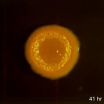(Press-News.org) Martian experts have known since 2011 that mysterious, possibly water-related streaks appear and disappear on the planet's surface. Georgia Institute of Technology Ph.D. candidate Lujendra Ojha discovered them while an undergraduate at the University of Arizona. These features were given the descriptive name of recurring slope lineae (RSL) because of their shape, annual reappearance and occurrence generally on steep slopes such as crater walls. Ojha has been taking a closer look at this phenomenon, searching for minerals that RSL might leave in their wake, to try to understand the nature of these features: water-related or not?
Ojha and Georgia Tech Assistant Professor James Wray looked at 13 confirmed RSL sites using Compact Reconnaissance Imaging Spectrometer for Mars (CRISM) images. They didn't find any spectral signature tied to water or salts. But they did find distinct and consistent spectral signatures of ferric and ferrous minerals at most of the sites. The minerals were more abundant or featured distinct grain sizes in RSL-related materials as compared to non-RSL slopes.
"We still don't have a smoking gun for existence of water in RSL, although we're not sure how this process would take place without water," said Ojha. "Just like the RSL themselves, the strength of the spectral signatures varies according to the seasons. The signatures are stronger when it's warmer and less significant when it's colder."
The research team also notes that the lack of water-related absorptions rules out hydrated salts as a spectrally dominant phase on RSL slopes. For example, ferric sulfates have been found elsewhere on Mars and are a potent antifreeze. If such salts are present in RSL, then they must be dehydrated considerably under exposure to the planet's conditions by the time CRISM observes them in the mid-afternoon.
The findings were recently published in Geophysical Research Letters, and the Georgia Tech duo's newest paper, published in the journal Icarus, indicates that predicting where RSL will appear is, at best, a guessing game.
Ojha, Wray, and several Arizona-based colleagues looked at every image gathered by the High Resolution Imaging Science Experiment (HiRISE) from March to October of 2011. They hunted for areas that were ideal locations for RSL formation: areas near the southern mid-latitudes on rocky cliffs. They found 200, but barely any of them had RSL.
"Only 13 of the 200 locations had confirmed RSL," said Ojha. "There were significant differences in abundance and size between sites, indicating that additional unknown factors such as availability of water or salts may play a crucial role in RSL formation."
Comparing their new observations with images taken in previous years, the team also found that RSL are much more abundant some years than others. Water on Mars today seems elusive at best – there one year, gone the next.
"NASA likes to 'follow the water' in exploring the red planet, so we'd like to know in advance when and where it will appear," Wray said. "RSL have rekindled our hope of accessing modern water, but forecasting wet conditions remains a challenge."
Ojha and Wray are also among several co-authors on another RSL-related paper published this month in Nature Geoscience. That study, led by the University of Arizona's Alfred McEwen, found some RSL in Valles Marineris, near the Martian equator.
INFORMATION:
Flowing water on Mars appears likely but hard to prove
Studies examine puzzling summertime streaks
2014-02-11
ELSE PRESS RELEASES FROM THIS DATE:
With their amazing necks, ants don't need 'high hopes' to do heavy lifting
2014-02-11
COLUMBUS, Ohio—High hopes may help move a rubber tree plant (as the old song goes), but the real secret to the ant's legendary strength may lie in its tiny neck joint.
In the Journal of Biomechanics, researchers report that the neck joint of a common American field ant can withstand pressures up to 5,000 times the ant's weight.
"Ants are impressive mechanical systems—astounding, really," said Carlos Castro, assistant professor of mechanical and aerospace engineering at The Ohio State University. "Before we started, we made a somewhat conservative estimate that they ...
Chips that listen to bacteria
2014-02-11
VIDEO:
The development of colony biofilms by Pseudomonas aeruginosa is affected by redox-active compounds called phenazines. A phenazine-null mutant forms a hyperwrinkled colony with prominent spokes, while wild-type colonies are more...
Click here for more information.
New York, NY—February 10, 2014—In a study published today in Nature Communications, a research team led by Ken Shepard, professor of electrical engineering and biomedical engineering at Columbia Engineering, ...
Manga comics may help promote fruit consumption among youth
2014-02-11
AUDIO:
May May Leung, Ph.D., R.D., discusses how a recent pilot study in Brooklyn, N.Y., with minority students found that exposure to manga comics (Japanese comic art) promoting fruit intake significantly...
Click here for more information.
PHILADELPHIA, PA, February 10, 2014 – A recent pilot study in Brooklyn, New York, with minority students found that exposure to Manga comics (Japanese comic art) promoting fruit intake significantly improved healthy snack selection. As ...
Political values influence people's response to health disparities messages
2014-02-11
PHILADELPHIA (February 10, 2014) – Policymakers and advocates discussing health disparities in the United States would be wise to consider the political affiliation of their audience, suggests a new study published in the Journal of Health Communication: International Perspectives (2014).
"Understanding Public Resistance to Messages about Health Disparities" was written by Sarah E. Gollust, University of Minnesota School of Public Health; and Joseph N. Cappella, Annenberg School for Communication, University of Pennsylvania. The study examines how political ...
TGen study uncovers possible genetic markers in breast cancer that spreads to the brain
2014-02-11
PHOENIX, Ariz. — Feb. 10, 2014 — The Translational Genomics Research Institute (TGen) has uncovered possible genetic origins of breast cancer that spreads to the brain, according to a first-of-its-kind study published in the scientific journal PLOS ONE.
The compendium of genetic targets uncovered by TGen now can be used to identify potential new methods of diagnosis and new drug therapies for the estimated 45,000 patients in the U.S. each year whose cancer spreads from the breast to the brain.
The 3-year study is significant since these patients currently have few treatments ...
New advance in 3-D printing and tissue engineering technology
2014-02-11
Boston, MA – Researchers at Brigham and Women's Hospital (BWH) and Carnegie Mellon University have introduced a unique micro-robotic technique to assemble the components of complex materials, the foundation of tissue engineering and 3D printing.
Described in the Jan. 28, 2014, issue of Nature Communications, the research was conducted by Savas Tasoglu, PhD, MS, research fellow in the BWH Division of Renal Medicine, and Utkan Demirci, PhD, MS, associate professor of Medicine in the Division of Biomedical Engineering, part of the BWH Department of Medicine, in collaboration ...
Breast cancer drug fights fungal disease
2014-02-11
Tamoxifen, a drug currently used to treat breast cancer, also kills a fungus that causes a deadly brain infection in immunocompromised patients. The findings, which could lead to new treatments for a disease that kills more HIV/AIDS patients than tuberculosis, appear in mBio®, the online open-access journal of the American Society for Microbiology (ASM.)
"This work sets the stage for additional animal studies to see if tamoxifen can be used as a drug in people and will allow us to design new drugs related to tamoxifen that are better antifungals," says Damian Krysan ...
Study shows drop in crime rates is less where Wal-Mart builds
2014-02-10
Communities across the United States experienced an unprecedented decline in crime in the 1990s. But for counties where Wal-Mart built stores, the decline wasn't nearly as dramatic.
"The crime decline was stunted in counties where Wal-Mart expanded in the 1990s," says Scott Wolfe, assistant professor of criminology and criminal justice at the University of South Carolina and lead author of a new study. "If the corporation built a new store, there were 17 additional property crimes and 2 additional violent crimes for every 10,000 persons in a county."
The study, titled ...
Newly found tactics in offense-defense struggle with hepatitis C virus
2014-02-10
The hepatitis C virus (HCV) has a previously unrecognized tactic to outwit antiviral responses and sustain a long-term infection. It also turns out that some people are genetically equipped with a strong countermeasure to the virus' attempt to weaken the attack on it.
The details of these findings suggest potential targets for treating HCV, according to a research team led by Dr. Ram Savan, assistant professor of immunology at the University of Washington. The study was published in Nature Immunology.
HCV infects more than 150 million of the world's people. The ...
NTU showcases expertise in UAV technology at Singapore Airshow 2014
2014-02-10
Nanyang Technological University (NTU) will be showcasing its latest R&D expertise in Unmanned Aerial Vehicle (UAV) technology at the Singapore Airshow, one of the most important aerospace and defence exhibitions in the world, held from 11 to 16 February.
Visitors to the Singapore Airshow will be able to see 12 drones, programmed by NTU scientists and researchers, flying in formation within inches of each other and executing complex indoor aerial manoeuvres.
In addition to the formation air-show by 12 quad-rotor Unmanned Aerial Vehicles complete with strobe lights ...
LAST 30 PRESS RELEASES:
Tracing the quick synthesis of an industrially important catalyst
New software sheds light on cancer’s hidden genetic networks
UT Health San Antonio awarded $3 million in CPRIT grants to bolster cancer research and prevention efforts in South Texas
Third symposium spotlights global challenge of new contaminants in China’s fight against pollution
From straw to soil harmony: International team reveals how biochar supercharges carbon-smart farming
Myeloma: How AI is redrawing the map of cancer care
Manhattan E. Charurat, Ph.D., MHS invested as the Homer and Martha Gudelsky Distinguished Professor in Medicine at the University of Maryland School of Medicine
Insilico Medicine’s Pharma.AI Q4 Winter Launch Recap: Revolutionizing drug discovery with cutting-edge AI innovations, accelerating the path to pharmaceutical superintelligence
Nanoplastics have diet-dependent impacts on digestive system health
Brain neuron death occurs throughout life and increases with age, a natural human protein drug may halt neuron death in Alzheimer’s disease
SPIE and CLP announce the recipients of the 2025 Advanced Photonics Young Innovator Award
Lessons from the Caldor Fire’s Christmas Valley ‘Miracle’
Ant societies rose by trading individual protection for collective power
Research reveals how ancient viral DNA shapes early embryonic development
A molecular gatekeeper that controls protein synthesis
New ‘cloaking device’ concept to shield sensitive tech from magnetic fields
Researchers show impact of mountain building and climate change on alpine biodiversity
Study models the transition from Neanderthals to modern humans in Europe
University of Phoenix College of Doctoral Studies releases white paper on AI-driven skilling to reduce burnout and restore worker autonomy
AIs fail at the game of visual “telephone”
The levers for a sustainable food system
Potential changes in US homelessness by ending federal support for housing first programs
Vulnerability of large language models to prompt injection when providing medical advice
Researchers develop new system for high-energy-density, long-life, multi-electron transfer bromine-based flow batteries
Ending federal support for housing first programs could increase U.S. homelessness by 5% in one year, new JAMA study finds
New research uncovers molecular ‘safety switch’ shielding cancers from immune attack
Bacteria resisting viral infection can still sink carbon to ocean floor
Younger biological age may increase depression risk in older women during COVID-19
Bharat Innovates 2026 National Basecamp Showcases India’s Most Promising Deep-Tech Ventures
Here’s what determines whether your income level rises or falls
[Press-News.org] Flowing water on Mars appears likely but hard to proveStudies examine puzzling summertime streaks






